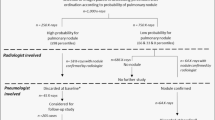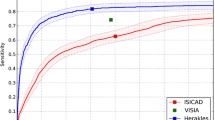Abstract
Computer-aided detection (CAD) systems allow the automatic identification of lung nodules on chest computed tomography (CT), providing a second opinion to the radiologist’s judgement and a volumetric evaluation of lesions — a very important aspect in oncological patients. The natural evolution of these systems has led to the introduction of computer-aided diagnosis (CADx) systems, which are able not only to identify nodules but also to characterise them by determining a likelihood of malignancy or benignity. The aim of this article is to describe the main technical principles of CAD and CADx systems, their applicability and influence in clinical practice and new prospects for their future development.
Riassunto
I sistemi computed aided detection (CAD) applicati alla tomografia computerizzata (TC) del torace, permettono l’identificazione automatica dei noduli polmonari, fornendo una seconda lettura al giudizio del radiologo e la valutazione volumetrica automatizzata delle lesioni, estremamente importante soprattutto in campo oncologico. La nuova frontiera nello sviluppo di questi sistemi è rappresentata dall’introduzione dei sistemi CAD di diagnosi (computed aided diagnosis) in grado non solo di effettuare l’identificazione dei noduli, ma anche una loro caratterizzazione, con l’elaborazione di un indice della probabilità di malignità o benignità della lesione. Lo scopo di questo articolo è quello di esporre i principi tecnici generali che regolano il funzionamento dei sistemi CAD, la loro applicabilità e influenza nella pratica clinica, e le nuove prospettive per il loro sviluppo nel panorama radiologico odierno in continua evoluzione.
Similar content being viewed by others
References/Bibliografia
Austin JH, Muller NL, Friedman PJ et al (1996) Glossary of terms for CT of the lungs: recommendations of the nomenclature committee of the Fleishner Society. Radiology 200:327–331
Bethany B (2003) The solitary pulmonary nodule. Chest 123:89–96
Yankelevitz DF, Hensche CI (2000) Lung cancer: small solitary pulmonary nodules. Radiol Clin North Am 38:1–9
Shaffer K (1997) Radiologic evaluation in lung cancer: diagnosis and staging. Chest 112:235–238
Fischbach F, Knollmann F, Griesshaber V et al (2003) Detection of pulmonary nodules by multislice computed tomography: improved detection rate with reduced slice thickness. Eur Radiol 13:2378–2383
Midthun DE (2000) Solitary pulmonary nodule: time to think small. Curr Opin Pulm Med 6:364–370
Li F, Sone S, Abe H et al (2002) Lung cancers missed at low-dose helical CT screening in a general population: comparison of clinical, histopathologic, and imaging findings. Radiology 225:673–683
Henschke CI, McCauley DI, Yankelevitz DF et al (1999) Early lung cancer action project: overall design and findings from baseline screening. Lancet 354:99–105
Henschke G (2000) work-up of the solitary nodule. American college of radiology. ACR Appropriateness Criteria. Radiology 215:607–609
Armato SG 3rd, Giger ML, Moran CJ et al (1999) Computerized detection of pulmonary nodules on CT scans. Radiographics 19:1303–1311
Awai K. et al (2004) Pulmonary nodules at chest CT: effect of computer aided diagnosis on radiologist’s detection performance. Radiology 230:347
Beigelman-Aubry et al (2007) Computed-Aided Detection of solid lung nodules on follow-up MDCT screening: evaluation of detection, tracking, and reading time. AJR 189:948–955
Bellotti et al (2007) A CAD system for nodule detection in low-dose lung CTs based on region growing and a new active contour model. Med Phys 4901–4910
Ozekes et al (2008) Nodule detection in a lung region that’s segmented with using genetic cellular neural networks and 3D template matching with fuzzy rule based thresholding. Korean J Radiol 9:1–9
Beyer et al (2007) Comparison of sensitivity and reading time for the use of computer-aided detection (CAD) of pulmonary nodules at MDCT as concurrent or second reader. Eur Radiol 17:2941–2947
White et al (2008) Lung nodule CAD software as second reader: a multi center study Acad Radiol 15:326–333
Giger ML, Bae KT, MacMahon H (1994) Computerized detection of pulmonary nodules in computed tomography images. Invest Radiol 29:459–465
Gurcan MN, Sahiner B, Petrick N et al (2002) Lung nodule detection on thoracic computed tomography images: preliminary evaluation of a computeraided diagnosis system. Med Phys 29:2552–2558
Kim JS, Kim JH, Cho G, Bae KT (2005) Automated detection of pulmonary nodules on CT images: Effect of section thickness and reconstruction interval- Initial results. Radiology 236:295–299
Fraioli F, Bertoletti L, Napoli A et al (2007) Computer-aided detection (CAD) in lung cancer screening at chest MDCT ROC analysis of CAD versus radiologist performance. J Thorac Imaging 22:241–246
Rubin GD, Lyo JK, Paik DS et al (2005) Pulmonary nodules on multidetector row CT scans: performance comparison of radiologists and computer-aided detection. Radiology 234:274–283
Das M, Mühlenbruch G, Heinen S et al (2008) Performance evaluation of a computer-aided detection algorithm for solid pulmonary nodules in low-dose and standard-dose MDCT chest examinations and its influence on radiologist. Br J Radiol 81:841–847
International Early Lung Cancer Action Program Investigators (2007) Computed tomographic screening for lung cancer: individualising the benefit of the screening. Eur Respir J 30:843–847
Wormanns D, Kohl G, Klotz E et al (2004) Volumetric measurements of pulmonary nodules at multi-row detector CT: in vivo reproducibility. Eur Radiol 14:86–92
Marten K, Engelke C (2007) Computer-aided detection and automated CT volumetry of pulmonary nodules. Eur Radiol 17:888–901
Marten K, Auer F, Schmidt S et al (2006) Inadequacy of manual measurements compared to automated CT volumetry in assessment of treatment response of pulmonary metastases. Eur Radiol 16:781–790
Hopper KD, Kasales CJ, Van Slyke MA et al (1996) Analysis of interobserever and intraobserver variability in CT tumor measurements. AJR Am J Roentgenol 167:851–854
Fraioli F, Bertoletti L, Napoli A et al (2006) Volumetric evaluation of therapy response in patients with lung metastases. Preliminary results with a computer system (CAD) and comparison with unidimensional measurements. Radiol Med 111:365–375
Larici AR, Storto ML, Torge M et al (2008) Automated volumetry of pulmonary nodules on multidetector CT: influence of slice thickness, reconstruction algorithm and tube corrent. Preliminary results. Radiol Med 113:29–42
Goo JM, Kim KG, Gierada DS et al (2006) Volumetric measurements of lung nodules with multi-detector row CT: effect of changes in lung volume. Korean J Radiol 7:243–248
Doi K (2007) Computer-aided diagnosis in medical imaging: Historical review, current status and future potential. Comput Med Imaging Graph 31:198–211
Goldin JG, Brown MS, Petkovska I (2008) Computer-aided diagnosis in lung nodule assessment. J Thorac Imaging 23:97–104
Li F, Aoyama M, Shiraishi J et al (2004) Radiologists’ performance for differentiating benign from malignant lung nodules on high-resolution CT using computer-estimated likelihood of malignancy. AJR Am J Roentgenol 183:1209–1215
Shah SK, McNitt-Gray MF, Rogers SR et al (2005) Computer aided characterization of the solitary pulmonary nodule using volumetric and contrast enhancement features. Acad Radiol 12:1310–1319
Passe TJ, Bluemke DA, Siegelman SS (1997) Tumor angiogenesis: tutorial on implications for imaging. Radiology 203:593–600
Tateishi U, Kusumoto M, Nishihara H et al (2002) Contrast-enhanced dynamic computed tomography for the evaluation of tumor angiogenesis in patients with lung carcinoma. Cancer 95:835–842
Mori K, Niki N, Kondo T et al (2005) Development of a novel computer-aided diagnosis system for automatic discrimination of malignant from benign solitary pulmonary nodules on thin-section dynamic computed tomography. J Comput Assist Tomogr 29:215–222
Nakamura K, Yoshida H, Engelmann R et al (2000) Computerized analysis of the likelihood of malignancy in solitary pulmonary nodules with use of artificial neural networks. Radiology 214:823–830
Gurney JW, Swensen SJ (1995) Solitary pulmonary nodules: determining the likelihood of malignancy with neural network analysis. Radiology 196:823–829
Henschke CI, Yankelevitz DF, Mateescu I et al (1997) Neural networks for the analysis of small pulmonary nodules. Clin Imaging 21:390–399
Buscema M (1997) A general presentation of artificial neural networks. I. Subst Use Misuse 32:97–112
Chen H, Wang XH, Ma DQ, Ma BR (2007) Neural network-based computer-aided diagnosis in distinguishing malignant from benign solitary pulmonary nodules by computed tomography. Chin Med J (Engl) 120:1211–1215
Gaeta M, Blandino A, Scrivano E et al (1999) Computer tomography halo sign in pulmonary nodules: frequency and diagnostic value. J Thorac Imaging 14:109–113
Buscema M et al (xxxx) Images as Active Connection Matrixes: the J-Net system. IC-MED 1:187
M. Buscema, L. Catzola, E. Grossi (2007) Images as active connection matrixes: the JNet System in International Journal of Intelligent Computing in Medical Sciences and Image Processing Vol I. No 3, Issue 1
Fraioli F, Bertoletti L, Mennini ML et al (xxxx) Applicazione clinica di un sistema di intelligenza artificiale applicato per la caratterizzazione automatica dei noduli polmonari basato su sistemi attivi di matrici neurali. SIRM, 43° Congresso Nazionale, xxxx
Author information
Authors and Affiliations
Corresponding author
Rights and permissions
About this article
Cite this article
Fraioli, F., Serra, G. & Passariello, R. CAD (computed-aided detection) and CADx (computer aided diagnosis) systems in identifying and characterising lung nodules on chest CT: overview of research, developments and new prospects. Radiol med 115, 385–402 (2010). https://doi.org/10.1007/s11547-010-0507-2
Received:
Accepted:
Published:
Issue Date:
DOI: https://doi.org/10.1007/s11547-010-0507-2




